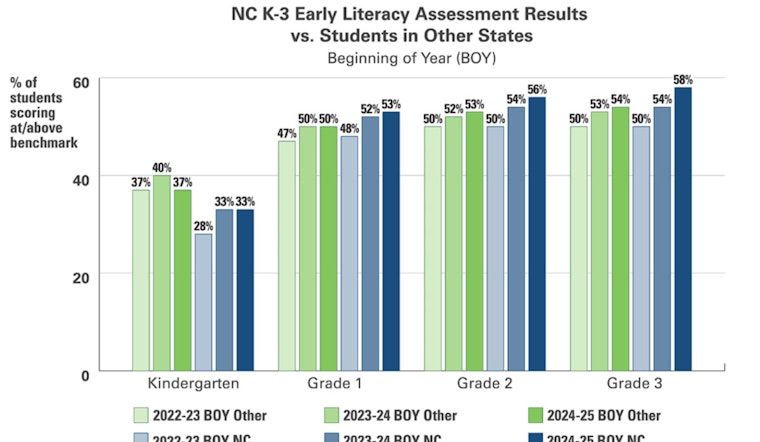Progress is in the pages for North Carolina’s youngest students as they chart new successes in foundational literacy skills, according to the latest data reviewed by the State Board of Education. The DIBELS 8 assessment indicates that students in grades 1-3 are outpacing their national peers, with the state’s K-3 students overall showing continued literacy improvement, as the North Carolina Department of Public Instruction reported.
Sculpted by the dedicated hands of over 44,000 educators, who have collectively invested more than 6.5 million hours in professional development through the Language Essentials for Teachers of Reading and Spelling (LETRS), North Carolina is reshaping its literacy landscape—and the results, for Black and American Indian/Alaska Native students especially, are clear evidence of this investment. As North Carolina kindergarteners, initially trailing nationally, advance beyond their counterparts after benefiting from the state’s refined instructional methods, they construct a narrative of resilience, and learning that transcends the constructs of race and early disadvantage. “We are not used to seeing this kind of growth in second and third grades, in particular. If you look at the cohort of students who started kindergarten in 2022-23, only 28 percent started school on track in literacy. By this year, when they’re in second grade, the percentage of those same students ready for grade-level work has nearly doubled,” State Superintendent Catherine Truitt is quoted in the North Carolina Department of Public Instruction report.
This progress visibly shrinks the racial achievement gap, with Black and American Indian/Alaska Native students’ on-track reading percentages rising above the national benchmark for the first time as revealed by the North Carolina Department of Public Instruction’s report. American Indian/Alaska Native students are pulling up to their White and Asian counterparts closer than ever before, resulting from a pedagogical metamorphosis grounded deeply in research-based reading science.
Truitt praised the progress driven by LETRS training, calling it “proof positive” that North Carolina’s investment. According to the North Carolina Department of Public Instruction, a group of students who started kindergarten in 2022-23 showed significant improvement, with the percentage of students ready for grade level nearly doubling by second grade. “It is a testament to the dedicated educators in our state who have poured hours and hours into LETRS professional development that we are seeing such exponential growth. I have no doubt that as they gain more experience and pedagogical tools steeped in the science of reading, student growth will continue to accelerate,” Truitt said to the DPI.
Note: Thank you for visiting our website! We strive to keep you informed with the latest updates based on expected timelines, although please note that we are not affiliated with any official bodies. Our team is committed to ensuring accuracy and transparency in our reporting, verifying all information before publication. We aim to bring you reliable news, and if you have any questions or concerns about our content, feel free to reach out to us via email. We appreciate your trust and support!



Leave a Reply